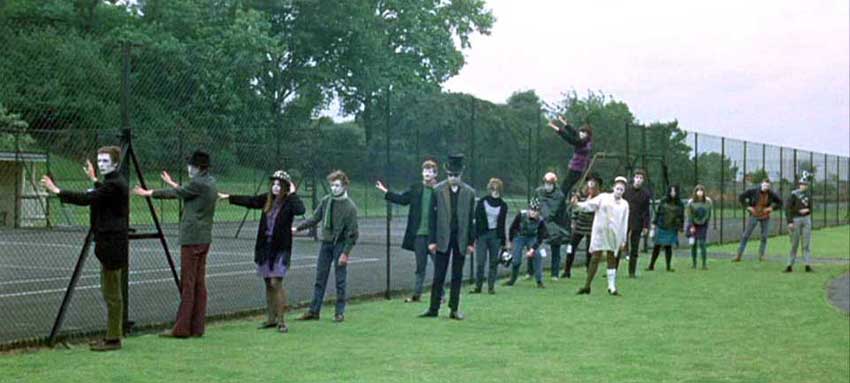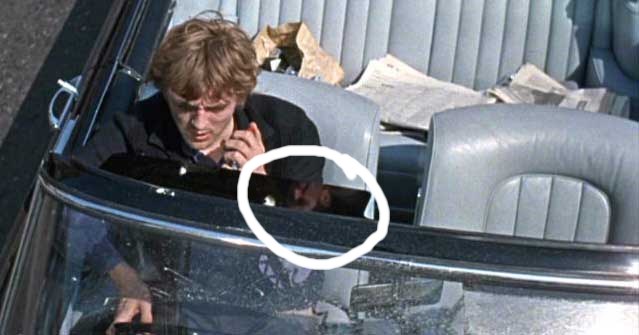|
The picture above pretty much says it
all, but I'm going to summarize the plot anyway, just because it's
fun. Unlike my usual bullshit summaries, I am not going to
exaggerate any details, because I don't have to in order to make them funny, although I will omit some
sub-plots and other minor elements.
COMPLETE SPOILERS AHEAD:
-
In a gray, decaying industrial zone
of London, a bunch of downtrodden factory workers lumbers out of
their mill. They have obviously challenged life and lost.
-
Meanwhile, in the toney West End, a
joyful group of gaily-dressed youth in white face (see above) motors through the heart of town
in a jeep. They are "ragging", a
technique used by young people at the time to collect for charities.
-
Back in the industrial area, one of
the factory workers waits for his colleagues to disperse. When he's
alone, he looks about furtively and walks over to where he has
parked his Rolls Royce convertible. He drives home to his enormous
and posh studio, where he proceeds to photograph a lifeless, deadpan
model for some time.
-
Then the photographer heads out to an
antique store in a different neighborhood, where he buys a
gargantuan airplane propeller, and debates buying the entire shop.
He thinks it's a good location for an antique store because he's
seen "fags with poodles" in the neighborhood.
-
While he is waiting for something at
the antique store, he wanders into a nearby park and photographs a
couple talking. The woman spots him taking pictures, catches up with
him, insists that he give her the film, and bites his hand when he
refuses. He continues to refuse, because there are other pictures on
the roll which do not concern the woman, but he says he will return
her pictures to her later.
-
He drives off to have lunch with his
friend/agent/editor. He orders a meal. He looks outside the restaurant and
sees a man fiddling with the trunk of his Rolls. He goes outside,
checks the trunk, finds nothing and drives home. (1) The agent is
left in the restaurant with two meals and no explanation for the
photographer's disappearance. (2) The mysterious trunk man is never
shown again. (3) There is nothing wrong with the trunk, and it is
never discussed again. This scene is either surreal or hilariously
inept, because the mysterious man first comes to the window of the
restaurant to see if the photographer is occupied. Then, when he
sees the photographer looking right at him and coming after him, he
heads straight to the trunk of the photographer's car and acts
mysterious. Yeah that makes sense. I wonder what he would have done
if the photographer had NOT noticed him.
-
When he drives home, he is visited by
the woman he photographed in the park, even though the park incident
happened in another neighborhood, and he never gave the woman his
address. She asks for the film. She takes off her blouse. The
antique store delivers the propeller. The photographer talks to the
topless woman for a while, but she offers no explanation for her
intense interest in the film. She is laughing theatrically with her
head back and her teeth exposed, seeming to have a good time. Then,
in the middle of a good guffaw, she stops laughing, gets up, puts on
her blouse, grabs the film and leaves with no explanation for her
change of mood.
-
We see that he gave her the wrong
roll of film.
-
He develops the correct roll of film,
and imagines that he has photographed something important, but he
doesn't know what. He takes the developed photos and hangs them
throughout his studio, noticing that they tell a story. He SAYS that he's photographed
the clues to a murder, though we have no idea precisely why he
believes that.
-
A couple of teenagers come over, and
he allows them to try on the clothing that he has used for
photographic shoots. He then tears off their clothes and rolls
around naked with them on a purple sheet.
(SIDEBAR: Many pretentious people
have written paragraphs to explain the presence of the two
mysterious men who lurk behind the three-way "purple sheet" sexual romp in this movie. Antonioni
explained, "There is no reason for it. They are two cameramen
whom I did not notice and so forgot to cut.")
-
More convinced than ever that he's
seen something important, the photographer returns to the mysterious park where he
took the pictures, and finds the dead body of the man he
photographed. For the only time in the course of the story, he does
not have his camera. Darn the luck!
-
He looks around his studio and finds
that the pictures are gone.
-
He attends a swingin' London
nightclub, where he sees the Yardbirds play (Jimmy Page and Jeff
Beck!). He stops into a place where people are smoking marijuana.
His friend/editor/agent is there. He tries to persuade his friend to
come and see the body he has found, but the man is stoned out of his
tree, and refuses.
-
The photographer goes back to the park the next
morning. The body is gone. Without the body and the pictures, he has
no evidence to share with anyone.
(SIDEBAR: Over the years, much has
been made of the fact that the grass clearly indicates that the body
was never there to begin with. and there are no signs that it has
been dragged away. That is accurate. A body lying there
for many, many hours would leave a trace. and there would be some
trace of it having been dragged from the spot. In fact, it would leave
all sorts of traces, not just bent blades of grass, but I strongly
doubt that Antonioni meant to convey that the body was never there.
Perhaps, but I doubt it. He was simply not capable of thinking so
logically. One cannot expect the photographer to reason that
through, because the filmmaker who created his character could not
reason that through. The problem with most people who question
objective reality is that they do not realize how detailed and
minute and precise objective reality is. If a good medical examiner
examined the site, he'd be able to tell you if a body was there, how
long the body was there, who the body belonged to, how much the man
weighed, and maybe even which cologne he had been wearing. This is
very similar to the weakness in the argument about the falling tree
not making a sound if nobody is there to hear it. It makes the
assumption that the record made by human ears is the only imprint
left by a sound on the universe.)
-
Then the photographer goes to another part
of the park. The
gaily-dressed youths from the opening scenes have gathered around a
tennis court. We now see that they are all trained mimes. (Hey, the
whiteface was a dead giveaway.) Two of them mime a
tennis game, while the others cheer (silently, of course). One of
the "players" hits an imaginary ball out of the court. All of the
mimes implore the photographer to fetch the ball. (Scene pictured
above.) He does. He gets the imaginary ball and throws in back into
the court. Then the camera pulls back, and he, too becomes as
imaginary and invisible as the ball.
-
As he disappears, we see the magic
words appear in his place: "The End".
(SIDEBAR: Once again, much has been
made of the fact that after the photographer throws the imaginary
ball back, we hear a REAL tennis game going on, with the sound of
real rackets hitting real balls. If intentional, this implies that
the mimes were never there, that the photographer was just strolling
past a real tennis game while imagining his mimed game. That seems
to be far too deep for Antonioni to have conceived, but I guess it is
possible. More likely, the sound is supposed to be in his head as he
buys into the false reality, or it is just another sloppy error, like the
crew members in the background.)
============
All hail the naked emperor.
The famous Italian filmmaker
Michelangelo Antonioni is a perfect litmus test for a person's
intellectual honesty. Show people Zabriskie Point or Blow-Up and ask
for their reactions. They will inevitably divide into two camps:
Camp 1 will use such words as
bewildering, pretentious, irrational, opaque, incoherent ...
Camp 2 will use such words and
expressions as alienation, disorientation, disaffection, angst, anomie, lack of communication,
elliptical ...
They are both saying the same thing,
but perceiving it in a different way: Antonioni's films make no
sense at all. The people in Camp 1 want them to make sense. The
people in Camp 2 believe that Antonioni was a genius at expressing
man's disconnection with the modern world, and that he was
re-inventing film with a new sense of narrative. The people in this
second camp think that the first group are fools for wanting
Antonioni to follow the traditional rules of language and narrative,
and they come up with fascinating explanations for all the logical
gaps in Antonioni's films, as if each non-sequitur were planned that
way by his subtle genius.
Other people argue that since
Antonioni wanted to picture the separation of modern man from his
environment, the banality and boredom of modern capitalist life, and
the inability of man to communicate, that he had to show people
being illogical, uncommunicative, boring, and alienated.
|


